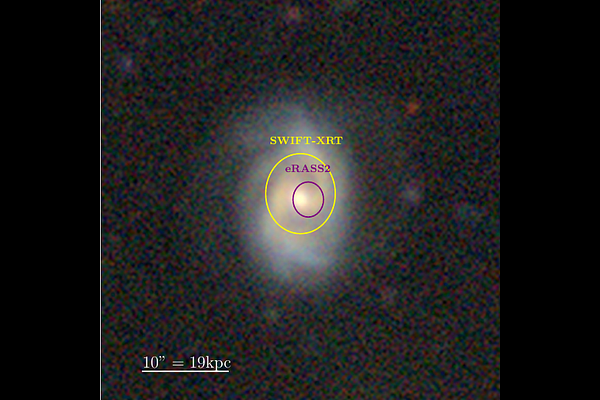A new Bowen Fluorescence Flare and Extreme Coronal Line Emitter discovered by SRG/eROSITA

A new Bowen Fluorescence Flare and Extreme Coronal Line Emitter discovered by SRG/eROSITA
Pietro Baldini, Arne Rau, Riccardo Arcodia, Taeho Ryu, Zhu Liu, Paula Sánchez-Sáez, Iuliia Grotova, Andrea Merloni, Stefano Ciroi, Adelle J. Goodwin, Mariusz Gromadzki, Adela Kawka, Megan Masterson, Dusán Tubín-Arenas, David A. H. Buckley, Francesco Di Mille, Gemma E. Anderson, Sabina Bahic, David Homan, Mirko Krumpe, James C. A. Miller-Jones, Kirpal Nandra
AbstractThe nuclear transient eRASSt J012026.5-292727 (J012026 hereafter) was discovered in the second SRG/eROSITA all-sky survey (eRASS2). The source appeared more than one order of magnitude brighter than the eRASS1 upper limits (peak eRASS2 0.2-2.3 keV flux of 1.14 x 10^-12 erg cm^-2 s^-1), and with a soft X-ray spectrum (photon index Gamma = 4.3). Over the following months, the X-ray flux started decaying, with significant flaring activity on both hour- and year-timescales. By inspecting the multiwavelength light curves of time-domain wide-field facilities, we detected a strong mid-infrared flare, evolving over 2 years, and a weaker optical counterpart. Follow-up optical spectroscopy revealed transient features, including redshifted Balmer lines (FWHM ~1500 km/s), strong Fe II emission, He II and Bowen lines, and high-ionization iron coronal lines. One spectrum showed a triple-peaked H-beta line, consistent with emission from a face-on elliptical disk. The spectroscopic features and the slow evolution of the event place J012026 within the classifications of Bowen fluorescence flares (BFFs) and extreme coronal line emitters (ECLEs). BFFs have been associated with rejuvenated accreting SMBHs, although the mechanism triggering the onset of the new accretion flow is still unclear, while ECLEs have been linked to the disruption of stars in gas-rich environments. The association of J012026 to both classes, combined with the multi-wavelength information, suggests that BFFs could be, at least in some cases, due to tidal disruption events (TDEs). The observed X-ray variability, uncommon in standard TDEs, adds complexity to these families of nuclear transients. These results highlight the diverse phenomenology of nuclear accretion events and demonstrate the value of systematic X-ray surveys, such as eROSITA and Einstein Probe, for uncovering such transients and characterizing their physical origin.